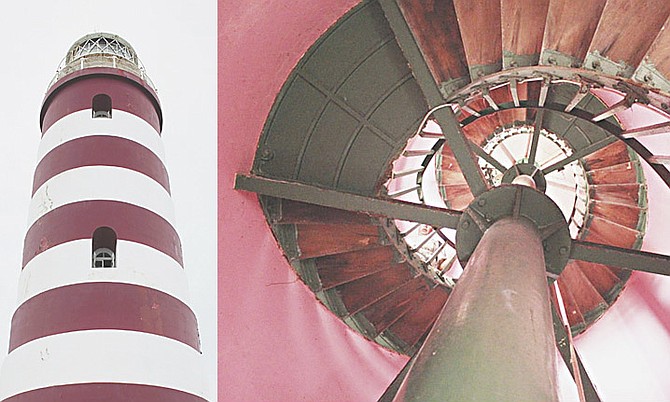By NICO SCAVELLA
Tribune Staff Reporter
nscavella@tribunemedia.net
ABACO’s lighthouse “lifeline” Everette Roberts died last weekend after a long battle with illness.
Mr Roberts was widely regarded as a fixture in the island’s maritime folklore for his dogged commitment to maintain lighthouses in the country. He died, aged 87, on Sunday.
For many years Mr Roberts traversed the waters of The Bahamas, acting as a supply lifeline to the nine lighthouses, which were often situated in – at the time –scarcely inhabited regions of the out islands.
Before the advent, and subsequent widespread utilization, of technology to better facilitate the maritime trade globally, sailors and sea navigators depended on the iconic structures to guide them along their way through the shallow and often treacherous Bahamian seas.
The fact that Mr Roberts was essentially responsible for ensuring the sustenance of the nine lighthouse keepers throughout the various islands – and their families – made Mr Roberts’ existence as lighthouse keeper for Bahamian lighthouses all the more significant.
His legacy was such that five years ago Mr Roberts was featured in a story written in 2010 by Jim Kerr, editor of Abaco Life Magazine, titled: “The way it was – Sustaining nine lighthouse keepers was his difficult job decades ago.”
In that story, it was recorded that Mr Roberts, a “family man living and working in Nassau, with experience in lumberyards and freight hauling,” was approached in 1967 by the British Imperial Lighthouse Service to establish a “seagoing routine that would ensure at least one re-supply visit a month to every lighthouse in the Bahamas.”
According to the article, the Lighthouse Service had built the nine Bahamas lighthouses during the 1800s as “vital navigational aids in an age before electronics and satellites, when all-too-often ships met an untimely end on the jagged coral reefs that fringe some of the world’s most travelled shipping lanes.”
Mr Roberts accepted the offer, and for six years reportedly supplied fuel and nourishment – grits, potatoes, rice, salt beef, and kerosene in 55-gallon drums – to the isolated lighthouse keepers and their families.
He reportedly made his supply calls in a 104-foot former U.S. Navy chaser named the Goldfinger, and later in a 147-foot former Navy LCI called the Anna Patricia. His wife, Peggy, and their four children often went along, and his son, Scotty, was first mate.
According to the article, Cay Lobos was Mr Robert’s first stop on the circuit and took an entire week. On another trip, the tender ship reportedly ran south to the four lighthouses there, followed by another week to Great Stirrup Cay in the Berry Islands, Great Isaac Cay – just northwest of the Bimini Islands, and the Abacos.
According to the article, some of the stations had as many as three keepers, many with small children. By 1973, however, the article said the number of manned stations had greatly diminished.
“The British automated all five of the ‘rock stations’ at a cost of about $35,000 each prior to Bahamian independence in 1973, and by the early 1990s, the Bahamas government had completed automation of two others, including Hole-in-the-Wall,” the article recorded. “Batteries powered the lights instead, and today there are only two manned stations left: Great Inagua and Elbow Reef at Hope Town, two significant historic landmarks that may yet be saved by preservation efforts.”
Meanwhile, however, after the Goldfinger and the Anna Patricia went to their watery graves, Mr Roberts resigned as deputy port director in charge of lighthouses, and in 1977, moved his family back to Green Turtle Cay. He and his daughter Crystal, managed the Abaco Yacht Services at the Green Turtle Shipyard for 25 years until his early 80s.
In his final years, his children, Crystal and Scott, were his primary caregivers.
On learning of his death many took to an online forum – abacoforum.com – to offer their condolences.
One man described Mr Roberts as “firm handed and completely reliable.”
“He taught me how to tie a bowline knot which is the only knot I know and it has saved me countless times,” he said. “Mr. Everette was one of the toughest men I have ever met. There was no doubt who the big dog was when he was around.”
Another lady said: “In late 1967, three months or so after I was born, my dad and two of his friends left Nassau on a small boat for a day of fishing. Unfortunately, their engine died and they ended up stranded on an uninhabited island. The weather was freezing cold and the ocean so rough that even BASRA wouldn’t go out to look for them. They spent the night on that island, wet and cold, in holes in the sand they dug to protect themselves against the elements.
“The next day, as I understand the story, someone with a private plane agreed to go up and search, and ended up spotting them on a deserted beach. And the only brave person willing to risk the rough seas to go and rescue them? Mr Everette Roberts.”
Mr Roberts’ funeral is scheduled for Monday, March 2, at the Miracle Church of God at 1pm.





Comments
Use the comment form below to begin a discussion about this content.
Sign in to comment
Or login with:
OpenID